_____
FBGP’s Football Cypher: 2017 New York Jets Preview
_____
FBGP’s Football Cypher: 2017 New York Jets Preview
_____
FBGP’s Football Cypher Podcast – 2017 New England Patriots Preview
____
Football Gameplan’s Football Cypher – 2017 Miami Dolphins Team Preview
____
Football Gameplan’s Football Cypher Podcast: Bills Team Preview
Gene Clemons, FBGP Analyst
While many in Tampa Bay focus on the flash and bright lights that will descend on One Buc Place when the Buccaneers open up training camp, they may miss some of the serious decisions that need to be made when filling out the roster. Going into training camp, there are five big offensive questions that will shape the Buccaneers “gameplan” this season.
1. Is moving Ali Marpet to center the best move?
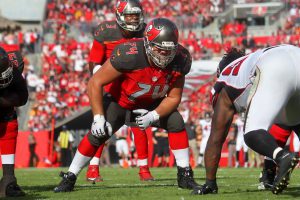 Marpet is a good, quality guard in the NFL but let’s not pretend he was a diamond in the rough. The Bucs used a second round pick on the Hobart prospect, making Marpet the 61st player selected. That means he is doing what was expected. While he is good, he’s not great and the NFL is a tough place to learn a new position. If Marpet is just going to be a younger Joe Hawley, or Evan Smith, why weaken a guard position (because the other guards are not as good)? It feels like a move for the sake of making a move. We will wait and see if it strengthens a line that really needs to improve.
Marpet is a good, quality guard in the NFL but let’s not pretend he was a diamond in the rough. The Bucs used a second round pick on the Hobart prospect, making Marpet the 61st player selected. That means he is doing what was expected. While he is good, he’s not great and the NFL is a tough place to learn a new position. If Marpet is just going to be a younger Joe Hawley, or Evan Smith, why weaken a guard position (because the other guards are not as good)? It feels like a move for the sake of making a move. We will wait and see if it strengthens a line that really needs to improve.
2. Who’s going to run the ball?
The Bucs roster is filled with question marks at the running back position. Doug Martin is unavailable for the beginning of the season due to suspension and when he played last 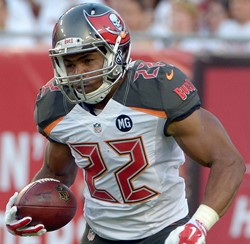 season, he wasn’t very effective. He will be motivated to keep that large price tag he has. Charles Sims has proven to be an effective third down back, but not a guy who can carry the load. Jacquizz Rodgers was a good surprise down the stretch last season, but he was also a guy out of football before then. Peyton Barber is a spot guy and rookie Jeremy McNichols is recovering from an injury. The one thing we know for sure is that the threat of the passing game should keep eight defenders out of the box.
season, he wasn’t very effective. He will be motivated to keep that large price tag he has. Charles Sims has proven to be an effective third down back, but not a guy who can carry the load. Jacquizz Rodgers was a good surprise down the stretch last season, but he was also a guy out of football before then. Peyton Barber is a spot guy and rookie Jeremy McNichols is recovering from an injury. The one thing we know for sure is that the threat of the passing game should keep eight defenders out of the box.
3. Who will replace the versatility of Russell Shepard?
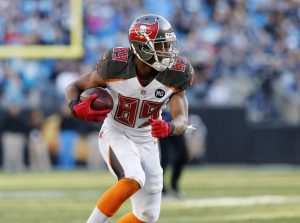
Wide Receiver Russell Shepard
We know that the top four guys are pretty set at the receiver position. Mike Evans, Desean Jackson, Adam Humphries, and rookie Chris Godwin give the Bucs potentially the most talented corps they’ve ever had. But Shepard was more than just depth and versatility at receiver, he was the best special teams player on the squad. The fifth, and possibly sixth receivers on the roster will need to be “special” on special teams. There are seven guys fighting for possibly two positions. With a legitimate return man still needed, Josh Huff and rookie Jesus “Bobo” Wilson will definitely get strong looks. Names like Martino and Dye will be familiar to fans, but don’t count out Bernard Reedy who has the most experience in the system and was on the cusp last season.
4. Will OJ Howard overtake Cameron Brate this season as the primary TE?
Regardless of how much you love Cameron Brate, and how much you appreciate his contribution last season, there’s one obvious problem: Brate can’t block. Clearly you don’t 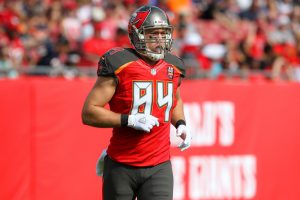 get rid of a receiving weapon, and Brate has proven to be just that, but Howard is bigger, faster, stronger, and yes he can block…really well! That versatility allows the play action game to rise to a new level, which equals more snaps for Howard in the run game. If Howard can be what the Bucs thought Austin Seferian-Jenkins would be, then Brate will certainly lose snaps. It will be difficult to unseat him but OJ has the juice to get it done. It will be a great battle to watch during camp and certainly means we will see many more two and three tight end formations.
get rid of a receiving weapon, and Brate has proven to be just that, but Howard is bigger, faster, stronger, and yes he can block…really well! That versatility allows the play action game to rise to a new level, which equals more snaps for Howard in the run game. If Howard can be what the Bucs thought Austin Seferian-Jenkins would be, then Brate will certainly lose snaps. It will be difficult to unseat him but OJ has the juice to get it done. It will be a great battle to watch during camp and certainly means we will see many more two and three tight end formations.
5, Why are the Bucs seemingly not willing to be patient with Roberto Aguayo?
Nobody will argue that Aguayo had a poor rookie campaign. Although he improved 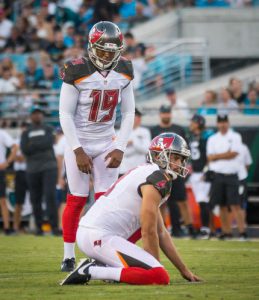 throughout the year, he still needs to get much better. This is nothing new with kickers. Many kickers with 10 plus years of NFL experience have had subpar seasons, and some really good ones have struggled out the gate. Fellow FSU alum Sebastian Janikowski struggled in his first season and is now continuing a hall of fame 17 season career. Aguayo, and the Bucs, can even look at the competition brought in to push him. Nick Folk had four straight seasons with a field goal percentage under 80% that includes a season where he connected on a dismal 64% of his chances. Despite that four year span of futility, Folk was given chances and has become a reliable kicker. He has impressed in OTAs and is apparently pushing the second year incumbent for full time kicking duties.
throughout the year, he still needs to get much better. This is nothing new with kickers. Many kickers with 10 plus years of NFL experience have had subpar seasons, and some really good ones have struggled out the gate. Fellow FSU alum Sebastian Janikowski struggled in his first season and is now continuing a hall of fame 17 season career. Aguayo, and the Bucs, can even look at the competition brought in to push him. Nick Folk had four straight seasons with a field goal percentage under 80% that includes a season where he connected on a dismal 64% of his chances. Despite that four year span of futility, Folk was given chances and has become a reliable kicker. He has impressed in OTAs and is apparently pushing the second year incumbent for full time kicking duties.
Questions? Comments?
Tweet: @geneclemons
Email: gclemons@footballgameplan.com
The NFL is the most popular sport in the United States. And while that statement isn’t backed by any data, I’m pretty sure it is still a correct assumption. We have long heard the cries for some sort of development league or minor league system for NFL because of the enormous amount of talented players, at all positions, that don’t make the final roster but are talented enough to be an NFL player. Major League Baseball and the NBA have a great player/prospect development system in place, and although college football provides the best training ground currently for the NFL, it’s not the same as pro development.
I wanted to dive into the possibility of what would an NFL G-League (or development league) would actually look like.
The Players
Right now there are currently 53-man rosters with a 10-player practice squad on an NFL team. Multiply that by 32-teams and the total is 2,016 NFL players. The question then turns to where will the players come from for this development league? It’s simple; they’ll come from the actual NFL team. Let me ‘splain.
NFL teams are allowed to take 90-man rosters into training camp. A lot of that number is comprised of newly drafted and undrafted rookie free agents. So, you’re looking at approximately 30-40 rookies, and 5-10 free agents on a training camp roster. The majority of those rookies and late free agent signings (players with maybe 1-2 years of NFL experience, but mainly practice squad-only experience) will more than likely be release prior to the regular season. Which is why we have a perceived ‘development problem’ in the league right now because there isn’t a lot of time, or reps to go around for the rookies or younger free agents to really get an opportunity to make the final 63. So, you’re looking at approximately 27 players that are NFL-level players on the street after training camp. There goes half of your roster for a 53-man development team. Where would the other 36 players come from? They would come from the same way the players that made the roster come from: the NFL Draft.
Right now the draft is 7-rounds long. It used to be as longer than that. I would expand the NFL-Draft to 14-rounds, with rounds 8-14 being the players that the team will allocate to their team-owned developmental squad (more on that later). That way, teams will have the ability to protect 7 more players before the undrafted free agent frenzy begins.
The Teams
In my honest, scouting opinion, there are enough talented NFL-level players coming out of college football every season. For example, last year I personally scouted and graded 532 college prospects (www.footballgameplan.com/FBGPScouting) that had next level talent. So, there are enough players to fill out a development league roster for each NFL team.
I’ve given each NFL team a development team in a nearby city that allows the players designated for that team to work out at the NFL teams facility. That way the coaches and players involved are all in the same building, going through the same strength and conditioning program, same physical training and same coaching philosophy/message. This also helps eliminate the cost of building an additional complex elsewhere. There also won’t be a need for construction of new stadiums either (unless owners choose to do so). Local small college stadiums or high school stadiums that are up to ‘pro standards’ would suffice for a developmental team. The goal is to make sure the team, coaches and players, get the live reps they need. In addition to keeping those costs down, having teams in nearby, medium-sized cities, it allows the parent NFL team to strengthen ties in another area of the state, growing the fan-base as a result.
Teams would have the same colors as the parent squad, which helps keep some brand continuity. With names similar to the parent squad as well.
Here’s what the teams in the league would look like:
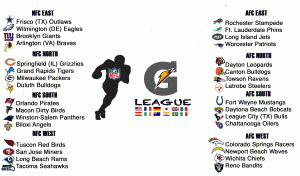 With the NFL being highly interested in expanding the brand globally, a developmental league also offers up the opportunity to create an international division as well. Overseas, there’s already a structure in place for football playing countries that play American football. It’s called the IFAF or International Federation of American Football (www.ifaf.info). Countries compete within their own leagues and teams qualify for the IFAF world championships. How the NFL G-League would fit into this would be to create an international division comprised of teams from certain countries: Germany, UK, Ireland, China, Japan, Austria, Italy, France, Australia, India, Sweeden, Spain & Mexico, with those country’s homegrown talent (non-import). For instance, ‘Team Germany” would consist of all German players that have qualified to make the team; similar to the olympics. The countries are all playing in leagues anyway, this would take the best of those leagues and place them on one team representing the country. That gives the NFL an opportunity to develop both international players and coaches as well.
With the NFL being highly interested in expanding the brand globally, a developmental league also offers up the opportunity to create an international division as well. Overseas, there’s already a structure in place for football playing countries that play American football. It’s called the IFAF or International Federation of American Football (www.ifaf.info). Countries compete within their own leagues and teams qualify for the IFAF world championships. How the NFL G-League would fit into this would be to create an international division comprised of teams from certain countries: Germany, UK, Ireland, China, Japan, Austria, Italy, France, Australia, India, Sweeden, Spain & Mexico, with those country’s homegrown talent (non-import). For instance, ‘Team Germany” would consist of all German players that have qualified to make the team; similar to the olympics. The countries are all playing in leagues anyway, this would take the best of those leagues and place them on one team representing the country. That gives the NFL an opportunity to develop both international players and coaches as well.
The Coaches
Not only would players benefit from a development league, but also so would up-and-coming coaches. Each NFL Team would be allowed to hire 15 additional assistant coaches, who would serve as the staff of the development team. This gives the parent NFL squad the opportunity to have the development players running the same system, same terminology as the NFL team. That way, if one of the players got called up to the parent squad, he can hit the ground running. Another benefit is for the coaches to get valuable repetitions in game-planning, scouting, and game-day situations. Continuity is key for an NFL team and having the additional coaches on staff to run the developmental team keeps everything streamlined.
The Schedule
One of the biggest concerns for NFL teams is the lack of ‘game ready’ players if someone gets injured. That’s why for a developmental league to truly work, the schedule has to coincide with the NFL schedule. Games would be played on Wednesday nights during the week, which allows the NFL to have content on Wednesday, Thursday, Sunday & Monday. The Players are getting valuable game experience and most importantly game tape post-college football. Also, it allows the teams to have players at their disposal that are in game shape, that’s familiar with the system, if they need to call up a player for a game on short notice. The regular season would be 10-games, no bye week, an 8-team playoff (8-division winners) with a title game.
The Cost
According to the website Spotrac.com, the base salary for an NFL player with 0 years of experience is $465,000. Obviously, that number won’t work for a developmental squad. The base salary for a developmental squad player would be $200,000. Multiplied by 53 players on the roster for a total player salary of $10.6 million dollars. Through collective bargaining, that money has to be included/allocated in the total salary cap, which continues to rise every year.
The Exposure
With the people having multiple ways of viewing content these days, a fully funded NFL Developmental League backed by the NFL, has a chance to be creative in delivering the content to consumers. The opportunity to offer these games only on Facebook Live, Amazon, Twitter, Yahoo, YouTube, Apple TV, in addition to NFL Network, gives the league a chance to thrive. The NFL has a unique opportunity to take full advantage of the digital, mobile-age consumer with this move.
As far as the fan experience is concerned, expectations for ticket sales and attendance should be that of a minor league baseball team. The goal and expectation should be around 3,500-10,000 per game, with 10,000 being the max. Think small to grow big should be the philosophy for the league with this project. It also should offer a much more affordable choice for a family to attend a game. The most important thing is the development of players and coaches, and if you can break even or make a tiny profit in the process, it should be considered a bonus.
This is just a fun exercise to create more opportunities for players, coaches, scouts and personnel people in the game of professional football. I’m pretty sure there’s a couple of things that I may have missed or left out. That’s why I want to keep this conversation going. Let’s build this thing together.
Share/add your idea with me on twitter @FBallgameplan using the hashtag #NFLGLeague.